
Vincent Willem van Gogh was a Dutch Post-Impressionist painter who is among the most famous and influential figures in the history of Western art. In just over a decade, he created approximately 2100 artworks, including around 860 oil paintings, most of them in the last two years of his life. His oeuvre includes landscapes, still lifes, portraits, and self-portraits, most of which are characterized by bold colors and dramatic brushwork that contributed to the rise of expressionism in modern art. Van Gogh's work was beginning to gain critical attention before he died at age 37, by what was suspected at the time to be a suicide. During his lifetime, only one of Van Gogh's paintings, The Red Vineyard, was sold.

The Potato Eaters is an oil painting by Dutch artist Vincent van Gogh painted in April 1885 in Nuenen, Netherlands.
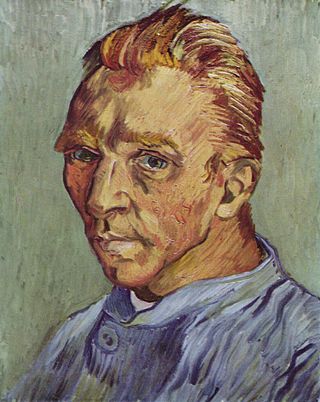
The portraits of Vincent van Gogh (1853–1890) include self-portraits, portraits of him by other artists, and photographs—one of which is dubious—of the Dutch artist. Van Gogh's dozens of self-portraits were an important part of his œuvre as a painter. Most probably, van Gogh's self-portraits are depicting the face as it appeared in the mirror he used to reproduce his face, i.e. his right side in the image is in reality the left side of his face.

The Starry Night is an oil-on-canvas painting by the Dutch Post-Impressionist painter Vincent van Gogh painted in June 1889. It depicts the view from the east-facing window of his asylum room at Saint-Rémy-de-Provence, just before sunrise, with the addition of an imaginary village. It has been in the permanent collection of the Museum of Modern Art in New York City since 1941, acquired through the Lillie P. Bliss Bequest. Widely regarded as Van Gogh's magnum opus, The Starry Night is one of the most recognizable paintings in Western art.
Vincent van Gogh lived during the Impressionist era. With the development of photography, painters and artists turned to conveying the feeling and ideas behind people, places, and things rather than trying to imitate their physical forms. Impressionist artists did this by emphasizing certain hues, using vigorous brushstrokes, and paying attention to highlighting. Vincent van Gogh implemented this ideology to pursue his goal of depicting his own feelings toward and involvement with his subjects. Van Gogh's portraiture focuses on color and brushstrokes to demonstrate their inner qualities and Van Gogh's own relationship with them.

Farms near Auvers or Thatched Cottages by a Hill is an oil painting by Vincent van Gogh that he painted in July 1890 when he lived in Auvers-sur-Oise, France. The painting is an example of the double-square canvases that he employed in his last landscapes.

Le Moulin de la Galette is the title of several paintings made by Vincent van Gogh in 1886 of a windmill, the Moulin de la Galette, which was near Van Gogh and his brother Theo's apartment in Montmartre. The owners of the windmill maximized the view on the butte overlooking Paris, creating a terrace for viewing and a dance hall for entertainment.
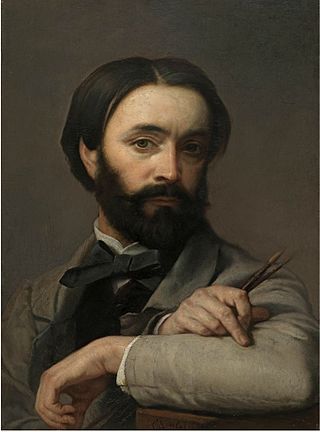
Charles Verlat or Karel Verlat was a Belgian painter, watercolorist, engraver (printmaker), art educator and director of the Antwerp Academy. He painted many subjects and was particularly known as an animalier and portrait painter. He also created Orientalist works, genre scenes, including a number of singeries, religious compositions and still lifes.
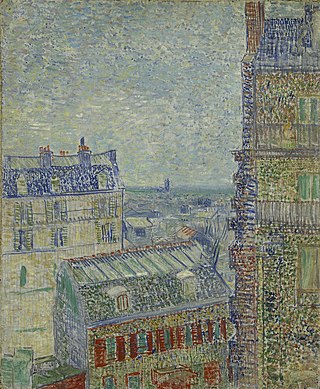
View of Paris from Vincent's Room in the Rue Lepic is the name of two paintings by the Dutch Post-Impressionist artist Vincent van Gogh from 1887, when he lived with his brother Theo in Paris.

The Montmartre paintings are a group of works that Vincent van Gogh created in 1886 and 1887 of the Paris district of Montmartre while living there, at 54 Rue Lepic, with his brother Theo. Rather than capture urban settings in Paris, van Gogh preferred pastoral scenes, such as Montmartre and Asnières in the northwest suburbs. Of the two years in Paris, the work from 1886 often has the dark, somber tones of his early works from the Netherlands and Brussels. By the spring of 1887, van Gogh embraced use of color and light and created his own brushstroke techniques based upon Impressionism and Pointillism. The works in the series provide examples of his work during that period of time and the progression he made as an artist.

Seine (paintings) is the subject and location of paintings that Vincent van Gogh made in 1887. The Seine has been an integral part of Parisian life for centuries for commerce, travel and entertainment. Here van Gogh primarily captures the respite and relief from city life found in nature.
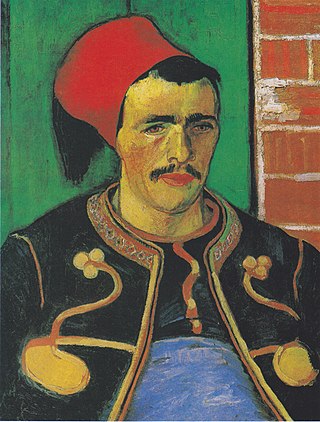
The Zouave is the subject of several sketches and paintings made by Vincent van Gogh in Arles, France in June 1888. The pieces range from close up oil painting portraits of the Zouave to full-body drawings. Van Gogh produced this collection of pieces during the period he spent in southern France, which many scholars regard as the zenith of his artistic career.Van Gogh nonetheless expressed frustration about his work during this time.

Still life paintings by Vincent van Gogh (Paris) is the subject of many drawings, sketches and paintings by Vincent van Gogh in 1886 and 1887 after he moved to Montmartre in Paris from the Netherlands. While in Paris, Van Gogh transformed the subjects, color and techniques that he used in creating still life paintings.
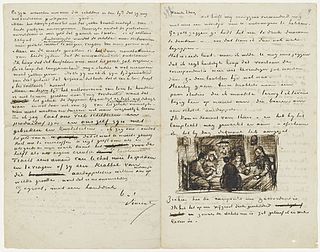
The Letters of Vincent van Gogh is a collection of 903 surviving letters written (820) or received (83) by Vincent van Gogh. More than 650 of these were from Vincent to his brother Theo. The collection also includes letters van Gogh wrote to his sister Wil and other relatives, as well as between artists such as Paul Gauguin, Anthon van Rappard, and Émile Bernard.

Skull of a Skeleton with Burning Cigarette is an early work by Vincent van Gogh. The small and undated oil-on-canvas painting featuring a skeleton and cigarette is part of the permanent collection of the Van Gogh Museum in Amsterdam. It was most likely painted in the winter of 1885–86 as a satirical comment on conservative academic practices. Before it was common to use live humans as models, the academic routine included the study of skeletons to develop an understanding of human anatomy. Van Gogh was in Antwerp, Belgium at that time attending classes at the Royal Academy of Fine Arts, which he later said were boring and taught him nothing.

Landscape with a Carriage and a Train is an oil painting by Vincent van Gogh that he painted in June 1890 when he lived in Auvers-sur-Oise, France.

Memory of the Garden at Etten (Ladies of Arles) is an oil painting by Vincent van Gogh. It was executed in Arles around November 1888 and is in the collection of the Hermitage Museum. It was intended as decoration for his bedroom at the Yellow House.
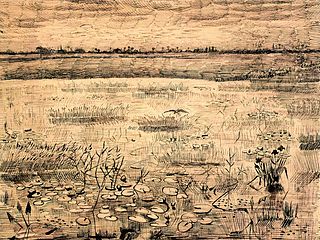
Marsh with Water Lilies is a drawing by Vincent van Gogh. It was executed at Etten in June 1881.

Portrait of Vincent van Gogh is an 1887 chalk pastel on cardboard by Henri de Toulouse-Lautrec. Toulouse-Lautrec had encountered Vincent van Gogh, eleven years his senior, when they were both taking lessons at the open studio of Fernand Cormon in Paris from 1886 to 1887. The painting is held by the Van Gogh Museum in Amsterdam, catalogued "d693V/1962".


















